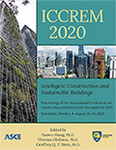International Conference on Construction and Real Estate Management 2020
Research on Disaster Risk Assessment of Deep Foundation Pit Engineering Based on Grey Clustering
Publication: ICCREM 2020: Intelligent Construction and Sustainable Buildings
ABSTRACT
In order to objectively evaluate the safety status of deep foundation pit engineering in disaster environment, a disaster risk assessment model for deep foundation pit engineering based on disaster theory combined with grey clustering is established. Based on hazard factor, bearing body, the disaster-resisting capability, and the characteristics of deep foundation pit engineering, deep foundation pit engineering disaster risk assessment index system was established. On this basis, AHP method and entropy weight method were used to determine the combined weights of evaluation indicators. After using gray clustering to establish a deep foundation pit disaster risk assessment model, and use this model for case analysis, the results are consistent with the actual situation.
Get full access to this article
View all available purchase options and get full access to this chapter.
REFERENCES
Chen, C.K., Chen, Y.Q., Shi, B. and Xu, T. (2018). “A model for evaluating urban resilience to rainstorm flood disasters.” China Safety Science Journal, 28(4), 1-6. (in Chinese).
Chen, W., Fu, J., Xiong, F.G. and Yang, W. (2016). “Construction safety gray clustering evaluation model for prefabricated building engineering.” Chinese Journal of Safety Science, 26(11), 70-75. (in Chinese).
Iqbal, J, and Amit Gorai. (2012). “AHP-GIS based drastic model for groundwater vulnerability to pollution assessment: a case study of Hazaribag district.” International Journal of Environmental Protection, 2(3), 20-31.
Quan, R.S. (2012). Risk assessment of flood disasters in typical coastal cities. East China Normal University, Shanghai, China, 93-94. (in Chinese).
Shi, P.J. (2002). “Three theories and practices of disaster research.” Journal of Natural Disasters, 111(3), 1-9. (in Chinese).
Wang, H., Liu, G.F. and Wang, H.M. (2014). “Early warning research on urban extreme rain and flood disaster based on cloud model.” Water Conservancy Economics, 32(4), 59-62+74. (in Chinese).
Wang, X.H. (2008). Research on subway construction disaster early warning model based on extension theory. Tianjin University of Technology, Tianjin China, 30-31. (in Chinese).
Wu, Z.H. and Ge, J.J. (2012). “Research on pre-control of natural disasters at construction sites.” Architecture and Construction, 25(1), 16-19. (in Chinese).
Yan, J. and Zuo, Z. (2010). “Research on index system and method of natural disaster risk assessment.” Chinese Journal of Safety Science, 20(11), 61-65. (in Chinese).
Zhan, H., Zhang, J.Q. and Han, J.S. (2005). “Research on risk assessment and zoning of flood disaster based on GIS technology—taking the middle and lower reaches of Liaohe River as an example.” Journal of Natural Disasters, 27(6), 141-146. (in Chinese).
Information & Authors
Information
Published In
ICCREM 2020: Intelligent Construction and Sustainable Buildings
Pages: 148 - 154
Editors: Yaowu Wang, Ph.D., Harbin Institute of Technology, Thomas Olofsson, Ph.D., Luleå University of Technology, and Geoffrey Q. P. Shen, Ph.D., Hong Kong Polytechnic University
ISBN (Online): 978-0-7844-8323-7
Copyright
© 2020 American Society of Civil Engineers.
History
Published online: Oct 14, 2020
Published in print: Oct 14, 2020
Authors
Metrics & Citations
Metrics
Citations
Download citation
If you have the appropriate software installed, you can download article citation data to the citation manager of your choice. Simply select your manager software from the list below and click Download.
